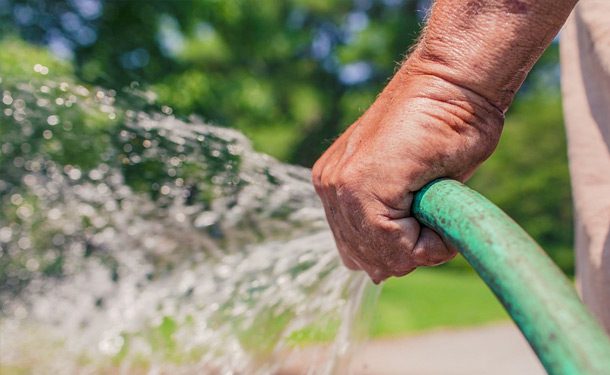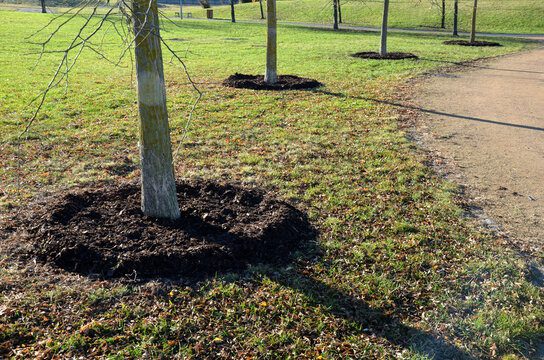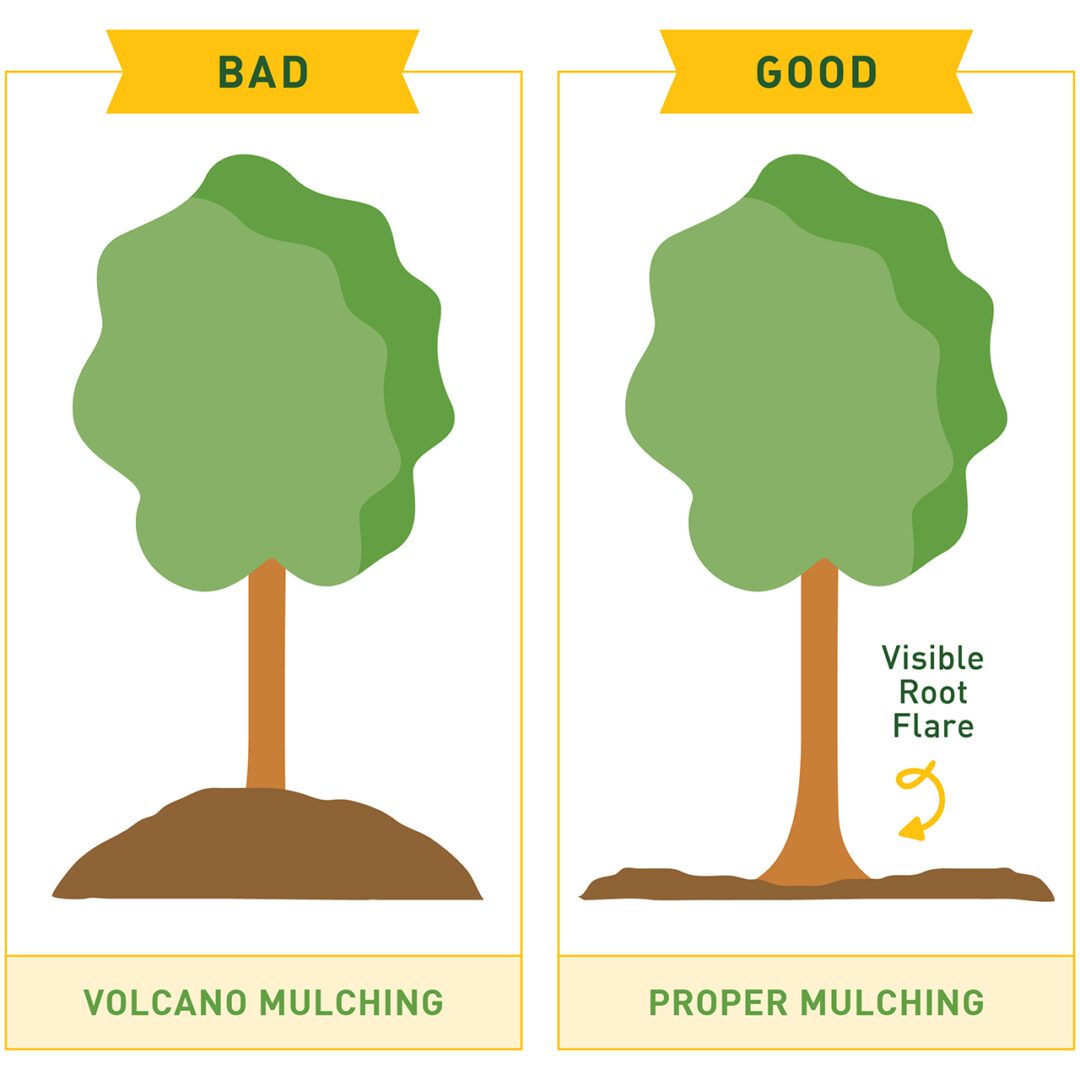Care for Semi Mature Trees
Watering
Trees will thrive without additional watering once they have fully rooted down, a process that takes two to three years after planting. Until then, watering is critical for the tree’s survival.
You can begin to water a newly planted tree any time from late March to early May, depending on the tree type and weather conditions. Start watering when the tree comes into leaf, or before that if the ground begins to dry out. Regular watering will be needed during the growth season; from April to October. Once the trees become dormant in the autumn watering is no longer necessary until buds open again the following spring. However, please monitor the weather in case we have a longer, Indian summer in which case, watering should continue as needed.
Evergreen trees need to be monitored during the autumn and winter, and may need a little water if these seasons are very dry.

The preferred routine is to water every week, or twice weekly during drought and preferably in the evening
As a general rule, give approximately 60 – 80 litres of water for every 6 ” of trunk diameter. Apply the water slowly so that it soaks into the area of the root-ball, or water via an irrigation system.
Watering should be regular regardless of heavy showers during the summer months. Downpours are unlikely to soak into the soil more than an inch or two, missing the root ball.
If the ground around the rootball is saturated, do not water that week and re-assess. Drainage may be a problem if water pools on top of the rootball/planting area, perhaps the soil is compacted. If this is the case use a fork to create holes for drainage so the soil does not become anaerobic (water-logged). Careful not to damage the rootball!
Over watering is as detrimental to the health of a tree as under watering. Under watering is often easier to spot and the most obvious sign is leaf wilting, if this is the case simply increase watering until the tree shows signs of improvement. Yellow leaves, spots on leaves, sudden leaf drop and die back on twigs, are all signs of over watering. If this happens reduce watering and check drainage around the root ball.
To check trees have the water they need, an hour after watering take a handful of soil from around the tree and squeeze it tight. The soil should feel moist but not saturated with water.
This watering regime is for the first two to three years following planting. Some smaller girth trees may be watered less frequently by the second or third year. However we advise continued monitoring for signs of dryness or stress.
Automatic Irrigation
Sometimes hand watering is not practical and the installation of an automatic watering system is the answer. A surface mounted irrigation system with a timer fitted to an outside tap is very effective and easy to install. We’re happy to offer advice and installation of these systems.
General Guide to Watering
|
Soil Type |
Light/Sandy |
Average/Loam |
Heavy /Clay |
|
|
Stem Girth |
Height – m |
Litres |
Litres |
Litres |
|
14-16cmg |
2.5-3.0 |
30 |
20 |
10 |
|
16-18cmg |
3.0-3.5 |
35 |
25 |
12 |
|
18-20cmg |
3.5-4.0 |
40 |
30 |
15 |
|
20-25cmg |
4.0-4.5 |
50 |
35 |
17 |
|
25-30cmg |
4.5-5.0 |
60 |
40 |
20 |
|
30-35cmg |
5.0-5.5 |
70 |
45 |
25 |
|
35-40cmg |
5.5-6.0 |
80 |
55 |
30 |
|
40-50cmg |
6.0-7.0 |
100 |
70 |
35 |
|
50-60cmg |
7.0-8.0 |
120 |
80 |
40 |
|
60cmg + |
8.0m + |
140 |
95 |
50 |
Mulching
We recommend a grass and weed free circle of about one metre around a newly planted tree. This will concentrate all available water and nutrients onto the root ball.
One meter of composted mulch – with a 10cm, mulch free ring around the trunk to avoid collar rot and trunk decay – will keep the area moist and free of weeds.
Mulching for one meter will also protect the tree bark and cambium layer (the growing part of the trunk) from potentially fatal damage often caused by strimmers and lawnmowers.


Tree Supports and Protection
Trees need to be supported correctly while new roots establish themselves. Some canopy flexing in the wind will do no harm to the tree and will in fact encourage rooting. But it is vital that the root ball is secured and does not rock. Movement of the root ball will cause the tree to lean and fine new roots will be severed, preventing the tree from taking up the moisture and nutrients it needs to survive.
Trees can be supported by tree stakes and ties which need to be checked regularly, especially after strong winds and rain. Make sure stakes are firm and ties have not come loose, and that the tree still feels secure.
Tree ties should be loosened as the tree grows to avoid strangling the tree and marks on the bark. If the tree is well rooted and stable, stakes must be removed after two to three seasons. All stakes and ties should eventually be taken off to protect the growth of the tree.
An alternative support for newly planted trees is the Platipus overhead or underground tree anchoring system. Underground guying is popular because the wire and anchors supporting the root ball are below the ground leaving a neater and more attractive finish to newly planted trees.
When using the overhead system it is important to check the guys regularly especially after strong winds. If the overhead guys have become slack or the tree has moved excessively in the wind, the system will need adjusting. Minor movement in the root ball is fine but excessive movement, for example, causing a large crack in the soil around the tree, will need remedial action. After two to three years, when the tree is fully rooted out and stable, the overhead guy wires can be removed by cutting the cable off just below the ground and removing the rest of the support system.
Tree guards
Some trees will need guards. As well as human damage from strimmers and lawnmowers, deer, sheep, horses, cattle and even rabbits can damage trees. With the right guards in place this can be prevented.
Each planting project will have different requirements from simple spiral guards and Tubex shelters to deer fencing around large parklands and elaborate metal tree guards lining avenues. Please give us a call for advice.
Tree Independence
Generally your tree should be well on its well to independence within 3 years of planting, if your tree appears to be struggling it may be caused by the following:-Incorrect watering – maybe too much or not enough. Please contact us if you have any concerns over watering.
Poor support causing ‘wind rock’ – check the tree support system and adjust. Please contact us if you need any advice or help.
Tree Independence
Decay around the base of the tree – check to see if the tree has been planted at the correct level. Remove any excess soil, mulch or litter around the base of the tree and check for any signs of decay. Please contact us if you have any concerns and would like help and advice.
Drainage and soil conditions – Is the area subject to water logging, does they soil need more nutrients, all these problems can be address with the correct advice and expertise. Please contact us if you have any concerns over drainage and soil conditions we are always happy to help and advice.
Pests & diseases – Trees are living organisms and as such are subject to various aphid infestations, fungal leaf spots and pests and diseases. Generally these are minor occurrences and will have little or no effect on the long term health & beauty of a semi mature tree. However if any pests or disease become an issue there will be a suitable remedial treatment for your tree. Please contact us for any concerns you may have and refer to our useful links section regarding some of the common tree pests and diseases.
Regular Checking
It is important to carry out regular visual checks of your trees to ensure they are establishing well and so will continue to thrive and flourish and give your enjoyment year after year. Things to look out for are:-Appearance of new buds and leaves in the spring. If you have any concerns over the lateness of your tree coming into leaf it is worth doing the ‘scratch test’ to determine if the tree is alive or dead; scrape away a little of the bark on a twig, if it is green underneath the tree is alive, if it is brown there is a problem with the tree and it would be best to contact us for advice.
Regular Checking
Leaf size and appearance – often in the first growing season after planting the new leaves will be smaller than the norm, however this nothing to worry about and the following year they should reach full size by the summer months. Also need to check for any mottled or discoloured appearance in the leaves which could be a sign of poor health.
Crown growth – the trees crown should get larger each year; check for any dead branches and if the crown is unbalanced. Most irregularities within the crown can be corrected by pruning.
Trunk and bark of the tree – some tree trunks will have naturally peeling and cracked bark as part of their characteristics. However the condition of the trunk and bark does need to be checked for any irregularities or signs of fungal growth, these may not be detrimental to the health of your tree but worth checking.
Pests and diseases – Although not always cause for concern any evidence of pests and diseases need to be noted and checked for peace of mind.

